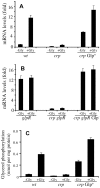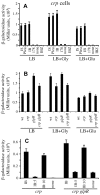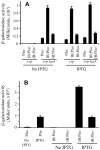A novel mechanism of transposon-mediated gene activation
- PMID: 19834539
- PMCID: PMC2753651
- DOI: 10.1371/journal.pgen.1000689
A novel mechanism of transposon-mediated gene activation
Abstract
Transposable Insertion Sequences (IS elements) have been shown to provide various benefits to their hosts via gene activation or inactivation under stress conditions by appropriately inserting into specific chromosomal sites. Activation is usually due to derepression or introduction of a complete or partial promoter located within the element. Here we define a novel mechanism of gene activation by the transposon IS5 in Escherichia coli. The glycerol utilization operon, glpFK, that is silent in the absence of the cAMP-Crp complex, is activated by IS5 when inserted upstream of its promoter. High-level expression is nearly constitutive, only mildly dependent on glycerol, glucose, GlpR, and Crp, and allows growth at a rate similar to or more rapid than that of wild-type cells. Expression is from the glpFK promoter and dependent on (1) the DNA phase, (2) integration host factor (IHF), and (3) a short region at the 3' end of IS5 harboring a permanent bend and an IHF binding site. The lacZYA operon is also subject to such activation in the absence of Crp. Thus, we have defined a novel mechanism of gene activation involving transposon insertion that may be generally applicable to many organisms.
Conflict of interest statement
The authors have declared that no competing interests exist.
Figures






Similar articles
-
Transposon-mediated activation of the Escherichia coli glpFK operon is inhibited by specific DNA-binding proteins: Implications for stress-induced transposition events.Mutat Res. 2016 Nov-Dec;793-794:22-31. doi: 10.1016/j.mrfmmm.2016.10.003. Epub 2016 Oct 27. Mutat Res. 2016. PMID: 27810619 Free PMC article.
-
A mechanism of transposon-mediated directed mutation.Mol Microbiol. 2009 Oct;74(1):29-43. doi: 10.1111/j.1365-2958.2009.06831.x. Epub 2009 Aug 4. Mol Microbiol. 2009. PMID: 19682247 Free PMC article.
-
Integration of regulatory signals through involvement of multiple global regulators: control of the Escherichia coli gltBDF operon by Lrp, IHF, Crp, and ArgR.BMC Microbiol. 2007 Jan 18;7:2. doi: 10.1186/1471-2180-7-2. BMC Microbiol. 2007. PMID: 17233899 Free PMC article.
-
Transposon-mediated adaptive and directed mutations and their potential evolutionary benefits.J Mol Microbiol Biotechnol. 2011;21(1-2):59-70. doi: 10.1159/000333108. Epub 2012 Jan 13. J Mol Microbiol Biotechnol. 2011. PMID: 22248543 Free PMC article. Review.
-
Control of Transposon-Mediated Directed Mutation by the Escherichia coli Phosphoenolpyruvate:Sugar Phosphotransferase System.J Mol Microbiol Biotechnol. 2015;25(2-3):226-33. doi: 10.1159/000375375. Epub 2015 Jul 9. J Mol Microbiol Biotechnol. 2015. PMID: 26159081 Free PMC article. Review.
Cited by
-
Global DNA hypomethylation of Alu and LINE-1 transposable elements as an epigenetic biomarker of anti-tuberculosis drug-induced liver injury.Emerg Microbes Infect. 2021 Dec;10(1):1862-1872. doi: 10.1080/22221751.2021.1976079. Emerg Microbes Infect. 2021. PMID: 34467830 Free PMC article.
-
Random sequences rapidly evolve into de novo promoters.Nat Commun. 2018 Apr 18;9(1):1530. doi: 10.1038/s41467-018-04026-w. Nat Commun. 2018. PMID: 29670097 Free PMC article.
-
Transposon-mediated directed mutation in bacteria and eukaryotes.Front Biosci (Landmark Ed). 2017 Mar 1;22(9):1458-1468. doi: 10.2741/4553. Front Biosci (Landmark Ed). 2017. PMID: 28199212 Free PMC article. Review.
-
Small RNAs, DNA methylation and transposable elements in wheat.BMC Genomics. 2010 Jun 29;11:408. doi: 10.1186/1471-2164-11-408. BMC Genomics. 2010. PMID: 20584339 Free PMC article.
-
Precise excision of IS5 from the intergenic region between the fucPIK and the fucAO operons and mutational control of fucPIK operon expression in Escherichia coli.J Bacteriol. 2010 Apr;192(7):2013-9. doi: 10.1128/JB.01085-09. Epub 2010 Jan 22. J Bacteriol. 2010. PMID: 20097855 Free PMC article.
References
-
- Friedberg EC, Walker GC, Siede W. DNA Repair and Mutagenesis. Washington, DC: ASM Press; 1995.
-
- Hengge-Aronis R. The general stress response in Escherichia coli. In: Storz G, Hengge-Aronis R, editors. Bacterial Stress Response. Washington, DC: ASM Press; 2000. pp. 161–178.
-
- Chandler M, Mahillon J. Insertion sequences revised. In: Craig NL, Craigie R, Gellert M, Lambowitz AM, editors. Mobile DNA II. Washington, DC: ASM Press; 2002. pp. 305–366.
-
- Galas DJ, Chandler M. Bacterial insertion sequences. In: Berg D, Howe M, editors. Mobile DNA. Washington DC: American Society for Microbiology; 1989. pp. 109–162.
Publication types
MeSH terms
Substances
Grants and funding
LinkOut - more resources
Full Text Sources
Other Literature Sources
Research Materials
Miscellaneous

